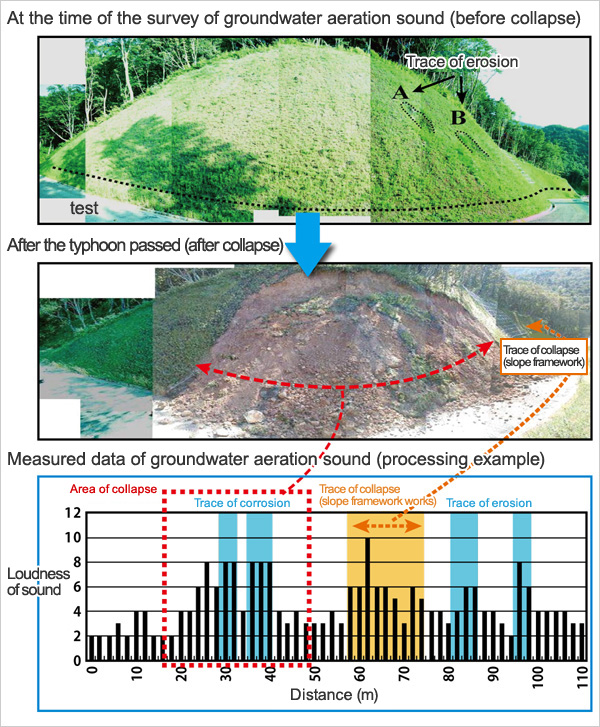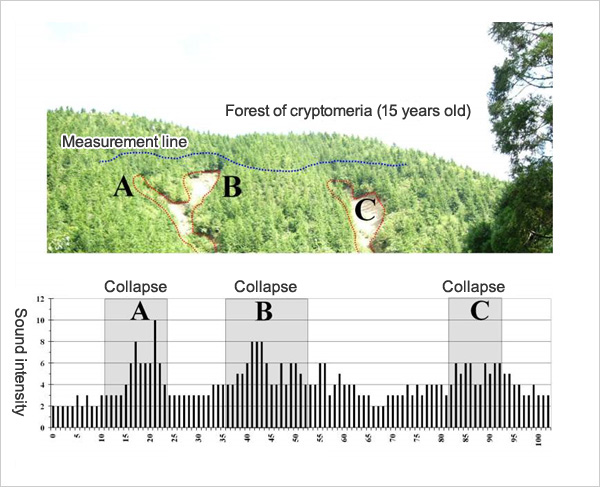Background of the development
For many years, a seepage of groundwater or a piping hole (Photo 1) were identified in a place where a collapse occurred, and from this it has been considered that a hazardous place where a collapse occurs is a slope having an underground structure where groundwater is likely to concentrate and a collapse is caused by excessive supply of groundwater to such a place at the time of a heavy rainfall.
In a mountainous area, if an exploration technique is available that enables a place where groundwater concentrates to be identified easily, the place of occurrence of a collapse can also be identified, but any of the conventional techniques such as boring and electrical exploration required a large sum of money as well as a lot of labor and plenty of time, it was practically impossible to apply these techniques widely to the exploration of hazardous areas.

About 10 years ago, with a view to identifying a place where groundwater concentrates in a simpler and more inexpensive manner than with such conventional techniques, researchers from the Forestry and Forest Products Research Institute (an independent administrative corporation), Kyoto University and Tottori University engaged in the development of a new technique called the "groundwater aeration sound exploration."
The "groundwater aeration sound exploration" is a technique by which the position where groundwater concentrates and flow is identified by the intensity of the aeration sound such as gurgling/bubbling sounds given off by a bursting of bubbles contained in the flow of underground water (groundwater flow) with the movement of groundwater.
First, a study was made to examine whether a place where groundwater concentrates can be identified non-destructively by detecting groundwater aeration sound from the surface of the ground by using this technique, and with the intensity of the groundwater aeration sound being greater in the vicinity of a point of spring water, it was confirmed that the technique is effective in identifying the place (Fig. 1).

Next, in order to verify whether this techniques can be applied to the forecast of a place of collapse, a place where groundwater concentrates was searched in an actual slope in a mountainous area, and forecast of a place of occurrence of a collapse was tried. Through a site survey, a place was picked out that was considered to have a louder sound of underground flowing water than that in slopes in the surrounding areas and to have concentrated groundwater. After this investigation, this slope was subjected to a heavy rainfall associated with a typhoon, and an actual occurrence of collapse of the hazardous area identified beforehand demonstrated the effective of this technique in the forecast as well (Fig. 2).

Next, as a result of measurement of ground aeration sound in many collapsed areas, it was clarified as shown in Fig. 3 that the ground aeration sound was louder in the collapsed areas than their surrounding areas.

In the meantime, a problem to be solved in the propagation of this technique was the skill required in judgment of aeration sound.
Hence, the researchers mainly from the Forestry and Forest Products Research Institute requested us to develop a "groundwater aeration sound exploration device" that enables a place where groundwater concentrates to be identified by anyone without having any special technical expertise with the same accuracy by making improvements on the technique for the judgment on groundwater aeration sound, and we started joint development with the Institute.
Use of this device has gradually started in the sites for prevention of sediment-related disasters as well, since the launching of its sale in the summer of 2013, and it is expected that the device will make great contributions to the prevention of sediment-related disasters that have frequently occurred in recent years.
It is our hope that this device will be utilized and exploited not only for the purpose of disaster prevention but also in solving various problems that are caused by groundwater.
